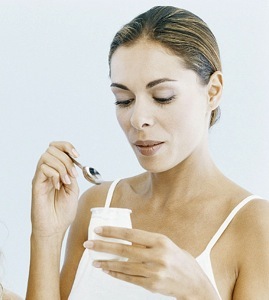-
Women’s Health Issues





Signs & Symptoms
For Bacterial Vaginosis (BV)
Nearly half of females with this infection notice no symptoms. When present, symptoms include:
-
•A thin, gray, or milky white vaginal discharge. This has a fishy odor. The odor is noticed more after sex.
-
•Mild vaginal irritation or burning.
For Vaginal Yeast Infections
These are also called Monilia, Candida, and fungal infections. Signs and symptoms range from mild to severe. They include:
-
•Thick, white vaginal discharge. This looks like cottage cheese. It may smell like yeast.
-
•Itching, irritation, and redness around the vagina.
-
•Burning and/or pain when passing urine or with sex.
Causes
For Bacterial Vaginosis (BV)
The exact cause is not known. It occurs when a certain bacteria outnumber normal bacteria in the vagina.
For Vaginal Yeast Infections
These result from the overgrowth of the fungus Candida. This is normally present in harmless amounts in the vagina, digestive tract, and mouth.
Risk Factors for Vaginal Yeast Infections
-
•Hormone changes that come with pregnancy or monthly periods. Taking hormones or birth control pills.
-
•Antibiotic use, especially “broad spectrum” ones. Corticosteroid medicine use.
-
•High blood sugar. This can occur when diabetes is not controlled.
-
•Using douches. Using feminine hygiene sprays.
-
•Using hot tubs or jacuzzis often. Sex that irritates the vagina a lot.
Chronic vaginal yeast infections can be one of the first signs of diabetes, STIs, and HIV.

Vaginal Infections
Vaginal infections are the most common reason females in the U.S. see their doctors. Vaginal infections cause vaginitis. This is swelling of the vagina.
Common vaginal infections are bacterial vaginosis (BV), vaginal yeast infections, and sexually transmitted infections STIs. (See information on STIs.)
Treatment
Different vaginal infections have the same symptoms. This makes it hard to tell one from another. A doctor may need to diagnose the cause. A sample of vaginal fluid is taken and tested. Often, this takes less than 3 minutes.
For Bacterial Vaginosis
-
•Prescribed antibiotic creams, gels, or pills are needed. The male sex partner(s) may also need treatment.
-
•Not using products that mask vaginal odor, such as feminine hygiene sprays.
-
•Over-the-counter (OTC) medications, such as ones for vaginal yeast infections do not treat BV.
For Vaginal Yeast Infections
-
•Prescribed or OTC antifungal vaginal creams or suppositories. These get rid of the Candida overgrowth.
-
•Oral medicines, such as Diflucan may be prescribed.

A doctor will prescribe the right treatment for a vaginal infection.
Questions to Ask







Self-Care / Prevention
-
•Take medications as prescribed.
-
•For a repeat vaginal yeast infection, use an over-the-counter (OTC) antifungal vaginal medication, such as Monistat. Use it as directed. {Note: Stop using any OTC product for a vaginal yeast infection at least 24 hours before a vaginal exam.}
-
•Ask your pharmacist about an OTC cream for itching and burning. This does not treat the infection, but may help with symptoms during treatment.
-
•Bathe or shower often. Clean the inside folds of the vulva. Dry the vaginal area well.
-
•Wipe from front to back after using the toilet.
-
•Don’t use bath oils, bubble baths, feminine hygiene sprays, or perfumed or deodorant soaps.
-
•If your vagina is dry, use a water soluble lubricant, such as K-Y Liquid when you have sex.
Eat yogurt with live cultures of lactobacillus acidophilus.
-
•Wear all-cotton underwear. Don’t wear garments that are tight in the crotch. Change underwear and workout clothes right away after you sweat.
-
•Don’t sit around in a wet bathing suit. Shower after you swim in a pool. This helps removethe chlorine from your skin. Dry the vaginal area well.
-
•Eat well. Include foods, such as yogurt, that have live cultures of “lactobacillus acidophilus.” Or, take an OTC product that has this.
-
•Limit sugar. Limit foods with sugar.
-
•Let your doctor know if you tend to get yeast infections when you take an antibiotic. You may be told to also use a vaginal antifungal product.
-
•If you still menstruate, use unscented tampons or sanitary pads. Change them often.
Do you have signs and symptoms of bacterial vaginosis listed above?
Does your skin and/or the whites of your eyes look yellow after you took a prescribed, oral antifungal medicine?
With symptoms of a vaginal yeast infection listed above, do you have any of these conditions?
-
•This is the first time for these symptoms.
-
•An infection was treated, but came back within 2 months.
-
•Diabetes.
-
•Symptoms don’t improve after using self-care measures for 3 days.
-
•Symptoms worsen or continue 1 week or longer after using self-care.



Get more information from:
HealthyLearn® | www.HealthyLearn.com. Click on MedlinePlus®.
National Women’s Health Information Center | 800.994.9662 | www.womenshealth.gov




Copyright © 2009, American Institute for Preventive Medicine. All rights reserved.